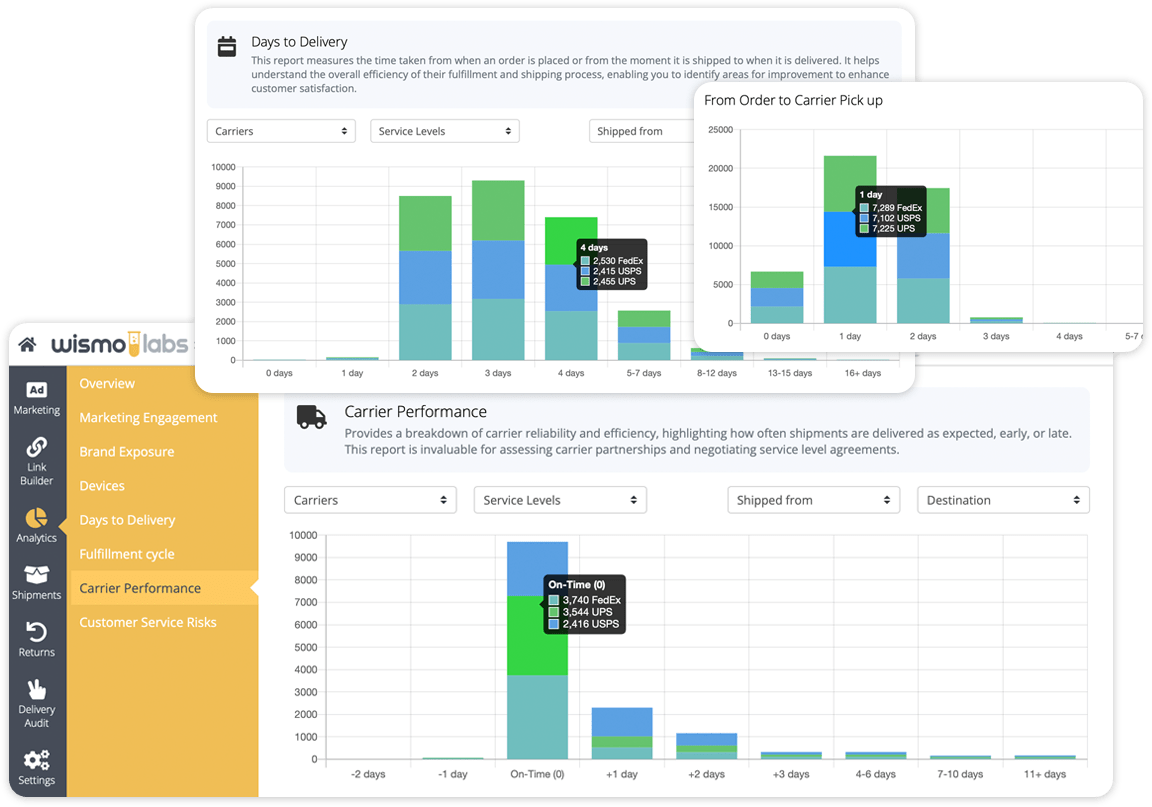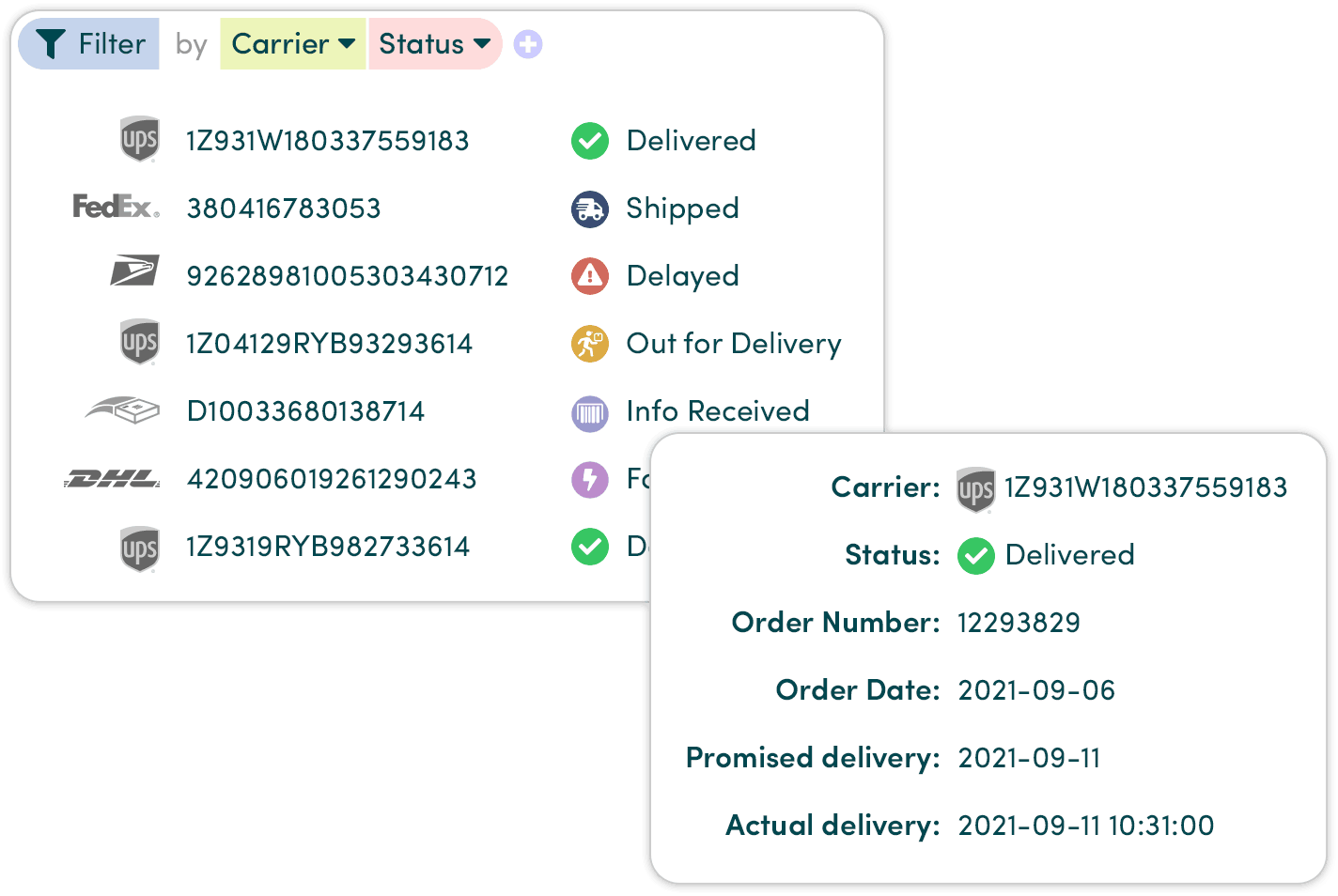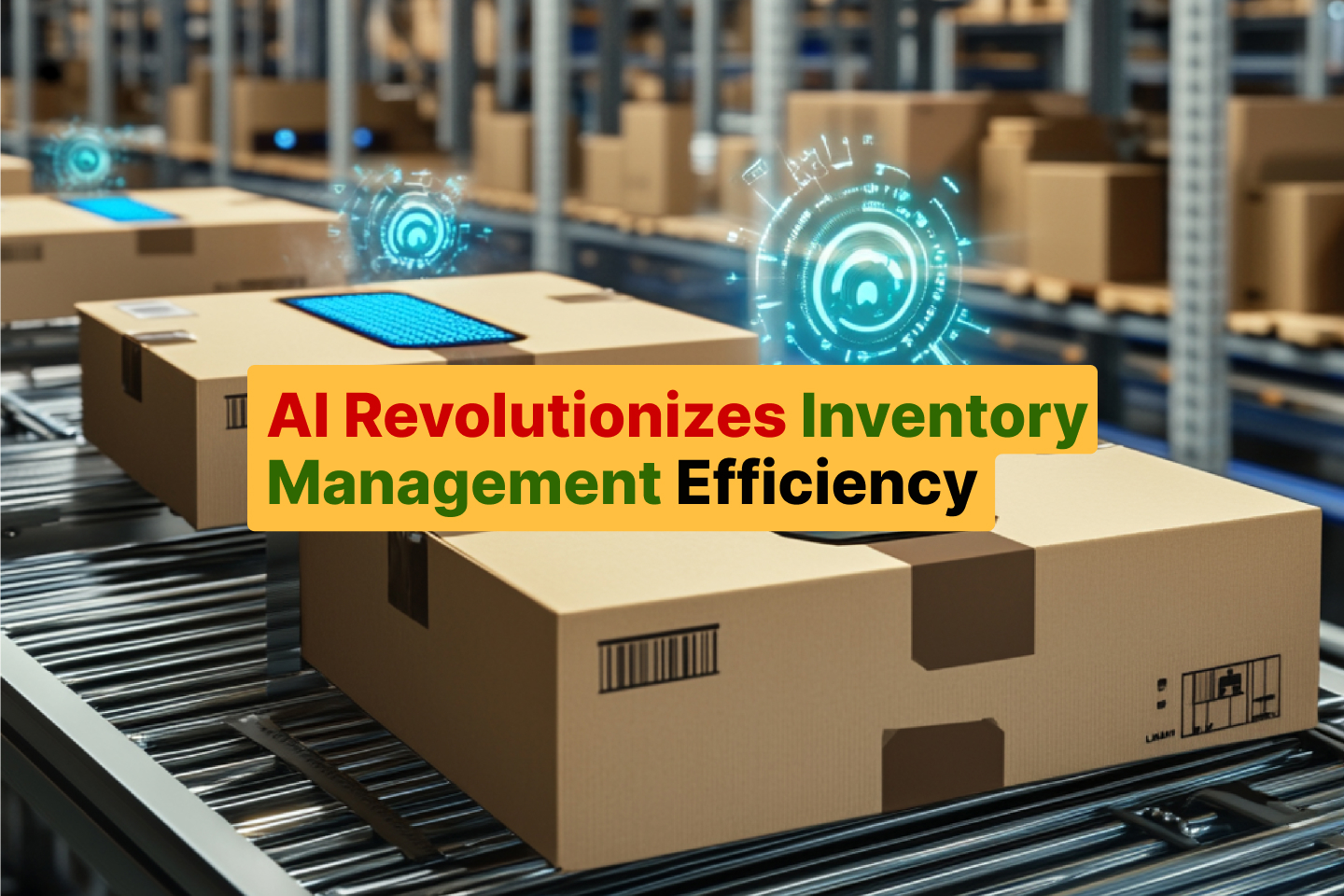Artificial Intelligence (AI) is transforming how businesses handle their inventory, creating unprecedented opportunities for optimization and strategic growth. This revolutionary technology makes inventory management more efficient, accurate, and cost-effective through sophisticated algorithms and machine learning capabilities that surpass traditional methods. AI uses advanced predictive analytics and real-time data processing to help businesses maintain optimal stock levels, anticipate customer demand patterns, and streamline their supply chain operations. Modern businesses face increasing pressure to deliver exceptional customer experiences while maintaining competitive pricing and operational efficiency. Companies that embrace AI-powered inventory management gain significant advantages through reduced waste, improved customer satisfaction, and enhanced profitability. Let’s explore how AI is revolutionizing inventory management efficiency and what this transformation means for businesses in today’s competitive marketplace.
Key Takeaways
- AI enables real-time tracking and visibility of inventory across multiple locations
- Predictive analytics powered by AI significantly improves demand forecasting accuracy
- Automated replenishment systems reduce manual work and minimize human error
- AI-driven inventory management leads to reduced operational costs and improved cash flow
- Enhanced customer satisfaction results from better product availability and faster order fulfillment
- AI facilitates more efficient returns management and data-driven decision making
Key Benefits of AI in Inventory Management
AI brings transformative advantages to inventory management by leveraging sophisticated machine learning algorithms and real-time data analysis to optimize every aspect of stock control. These intelligent systems can process vast amounts of information from multiple sources, including sales data, market trends, seasonal patterns, and external factors to create comprehensive insights that drive strategic decision-making. The integration of AI into inventory management processes enables businesses to move beyond reactive approaches to proactive, predictive strategies that anticipate market demands and customer needs. By analyzing historical patterns and current market conditions, AI systems can identify subtle trends and correlations that human analysts might overlook, leading to more accurate forecasting and improved operational efficiency.
AI Inventory Management Core Benefits
Instant inventory tracking
Predictive analytics accuracy
Smart replenishment
Reduced operational expenses
Enhanced shopping experience
- Real-time tracking and visibility across all inventory locations, providing instant updates on stock levels and movement patterns
- Demand forecasting accuracy through advanced machine learning algorithms that analyze multiple data sources and market indicators
- Automated replenishment systems that optimize ordering schedules and quantities based on predictive analytics and real-time demand signals
- Reduced operational costs through minimized waste, optimized storage utilization, and improved labor efficiency across warehouse operations
- Enhanced customer satisfaction resulting from improved product availability, faster order fulfillment, and more accurate delivery estimates
These comprehensive benefits enable businesses to operate more efficiently while delivering superior customer experiences and maintaining competitive advantages in their markets. For example, AI-powered inventory systems can automatically trigger reorders when stock levels reach predetermined thresholds, ensuring that popular items remain available while avoiding excess inventory that ties up capital. The sophisticated algorithms can analyze historical sales data, seasonal trends, weather patterns, and economic indicators to optimize stock levels across different locations and product categories. This intelligent approach to inventory management transforms reactive processes into proactive strategies that anticipate market demands and customer preferences before they manifest in sales data.
Real-Time Tracking: The Foundation of AI-Powered Inventory Management
Real-time tracking represents the cornerstone of modern AI-powered inventory management, providing businesses with unprecedented visibility into their stock levels, product movements, and supply chain dynamics. This advanced capability integrates data from multiple sources including point-of-sale systems, warehouse management software, IoT devices, and mobile scanning applications to create a comprehensive, up-to-the-minute view of inventory status across all locations. The power of real-time tracking lies in its ability to eliminate the delays and inaccuracies associated with traditional inventory management methods, which often relied on periodic manual counts and batch processing. Modern AI systems can process thousands of inventory transactions per second, updating stock levels instantaneously and providing managers with accurate information needed for critical business decisions.
Real-Time Tracking System Architecture
Instant data capture
AI processing hub
Real-time insights

The implementation of real-time tracking systems creates a dynamic, responsive inventory management environment where businesses can react immediately to changing conditions and market demands. These systems continuously monitor stock movements, automatically updating inventory records as products are received, moved, sold, or returned, eliminating the lag time that traditionally existed between physical inventory changes and system updates. Advanced AI algorithms can even predict potential stockouts or overstock situations before they occur, enabling proactive management decisions that prevent costly inventory problems. This predictive capability extends beyond simple reorder point calculations to include sophisticated analysis of seasonal trends, promotional impacts, and market dynamics that affect inventory requirements.
- Shows when stock is running low, enabling timely reorder decisions and preventing stockout situations that could impact customer satisfaction
- Helps find lost or misplaced items quickly through precise location tracking and intelligent search capabilities within warehouse management systems
- Makes it easier to spot trends in product performance by providing immediate visibility into sales velocity and demand patterns across different time periods
- Reduces the chance of overselling items by maintaining accurate, real-time inventory counts that prevent orders for unavailable products
AI-powered shipment tracking extends these capabilities beyond warehouse walls to provide comprehensive visibility of products throughout the entire supply chain journey. This integrated approach enables businesses to provide customers with accurate delivery estimates while proactively addressing potential delays or issues before they impact customer satisfaction. Advanced AI algorithms analyze transportation patterns, weather conditions, and carrier performance data to predict and prevent supply chain disruptions, ensuring smooth inventory flow from suppliers to customers.
Predictive Analytics: Forecasting Demand with AI
Predictive analytics represents one of the most powerful applications of AI in inventory management, transforming how businesses anticipate and prepare for future demand patterns. These sophisticated systems analyze vast amounts of historical data, market trends, seasonal patterns, and external factors to generate accurate forecasts that go far beyond traditional statistical methods. By processing information from multiple sources including sales records, weather forecasts, economic indicators, social media sentiment, and industry trends, AI-powered predictive analytics can identify complex patterns and correlations that human analysts might miss. This comprehensive approach enables businesses to make more informed decisions about inventory levels, purchasing strategies, and resource allocation.
Predictive Analytics Data Sources

The sophistication of modern predictive analytics extends beyond simple trend analysis to include complex machine learning models that can adapt and improve their accuracy over time. These systems learn from their prediction successes and failures, continuously refining their algorithms to provide increasingly accurate forecasts as they process more data. The ability to incorporate real-time information means that predictions can be updated dynamically as new data becomes available, allowing businesses to adjust their inventory strategies in response to changing market conditions. This adaptive capability is particularly valuable in volatile markets or during unexpected events that can dramatically alter demand patterns.
- Order the right amount of stock by analyzing historical sales patterns, seasonal fluctuations, and market trends to optimize inventory levels and minimize excess or shortage situations
- Plan for busy seasons and special events using predictive models that account for promotional activities, holidays, and market events that typically drive demand spikes
- Spot new trends before they become mainstream through analysis of emerging patterns in customer behavior, social media sentiment, and early market indicators
- Decide which products to focus on and phase out based on predictive analysis of product lifecycle stages, market saturation, and changing consumer preferences
Using data analytics for demand forecasting creates significant competitive advantages by enabling businesses to anticipate market changes and adjust their strategies proactively rather than reactively. This forward-looking approach helps companies optimize their pricing strategies, identify cross-selling opportunities, and even predict which products are likely to be returned, allowing for more comprehensive inventory planning. AI-driven predictive analytics can also help businesses optimize their supplier relationships by providing accurate demand forecasts that enable better planning and coordination throughout the supply chain.
Automated Replenishment: Streamlining Stock Management
Automated replenishment systems represent a significant leap forward in inventory management efficiency, utilizing AI algorithms to eliminate manual ordering processes while optimizing stock levels across multiple locations and product categories. These intelligent systems continuously monitor inventory levels, sales velocity, and demand patterns to automatically generate purchase orders when predetermined thresholds are reached or when predictive models indicate future stockout risks. The sophistication of modern automated replenishment extends beyond simple reorder point calculations to include complex algorithms that consider factors such as supplier lead times, minimum order quantities, volume discounts, seasonal variations, and promotional impacts. This comprehensive approach ensures that ordering decisions are based on complete information rather than simplified rules.
Automated Replenishment Workflow
The intelligence built into automated replenishment systems enables them to adapt to changing business conditions and optimize ordering strategies continuously. These systems can analyze supplier performance data to adjust lead times and reliability factors, evaluate price fluctuations to time purchases for maximum cost savings, and coordinate orders across multiple suppliers to minimize shipping costs and delivery complexity. Advanced AI algorithms can also factor in warehouse capacity constraints, cash flow considerations, and seasonal storage requirements to optimize not just what to order, but when and how much to order for maximum efficiency and cost-effectiveness.
- Saves time that would be spent manually checking and ordering stock by automating routine replenishment decisions and freeing staff to focus on strategic activities
- Reduces the chance of human error in ordering through systematic, algorithm-driven processes that eliminate mistakes from manual calculations and data entry
- Can adjust orders based on real-time sales data by continuously monitoring demand patterns and modifying replenishment schedules to match current market conditions
- Helps keep just the right amount of stock on hand by balancing carrying costs against stockout risks to optimize overall inventory investment
Automated shipment notifications integrate seamlessly with replenishment systems to provide complete visibility into the ordering and delivery process, keeping businesses and customers informed about stock availability and expected arrival times. This integrated approach creates a smooth, transparent supply chain process that builds trust with customers while enabling businesses to plan their operations more effectively. The combination of automated ordering and intelligent notifications ensures that inventory flows smoothly through the supply chain while maintaining optimal stock levels and customer satisfaction.
Enhancing Customer Experience through AI-Powered Inventory Management
The impact of AI-powered inventory management extends far beyond operational efficiency to create transformative improvements in customer experience and satisfaction. When inventory systems function optimally, customers benefit from consistent product availability, accurate delivery estimates, and personalized shopping experiences that anticipate their needs and preferences. AI enables businesses to maintain the delicate balance between having sufficient stock to meet demand while avoiding the costs associated with excessive inventory, creating a win-win situation for both businesses and customers. The sophisticated algorithms can analyze individual customer behavior patterns, purchase history, and preferences to create personalized inventory allocations that ensure high-demand items are available when and where customers expect them.
Customer Experience Enhancement Through AI
Reduced stockouts and better inventory planning
Tailored recommendations and inventory allocation
Faster order fulfillment and delivery
AI-powered inventory management systems create a more responsive and intelligent retail environment where customer needs are anticipated and addressed proactively. These systems can predict which products individual customers are likely to purchase and ensure those items are readily available, while also identifying opportunities for complementary product suggestions based on inventory availability and customer preferences. The integration of AI with customer relationship management systems enables businesses to create personalized shopping experiences that consider both customer preferences and real-time inventory availability, resulting in higher conversion rates and customer satisfaction scores.
- Reducing the number of times items are out of stock through predictive analytics that anticipate demand and ensure adequate inventory levels are maintained across all sales channels
- Providing accurate information about when items will be back in stock using AI-powered forecasting that considers supplier lead times, production schedules, and demand patterns
- Offering personalized product recommendations based on inventory data by analyzing customer preferences alongside available stock to suggest relevant alternatives when preferred items are unavailable
- Enabling faster shipping times through better warehouse management by optimizing inventory placement and picking routes to reduce order fulfillment time and improve delivery speed
AI-powered order tracking represents another crucial component of enhanced customer experience, providing real-time updates that reduce anxiety and build confidence in the purchasing process. These intelligent systems can predict potential delays, proactively communicate with customers about order status changes, and even suggest alternative solutions when problems arise, transforming potentially negative experiences into demonstrations of excellent customer service and operational transparency.
Cost Reduction and Operational Efficiency
The financial impact of AI-powered inventory management extends throughout every aspect of business operations, creating substantial cost savings and efficiency improvements that directly contribute to profitability and competitive advantage. These intelligent systems optimize multiple cost centers simultaneously, including inventory carrying costs, warehouse operations, labor utilization, and supply chain logistics, resulting in comprehensive operational improvements that compound over time. AI algorithms can analyze complex cost relationships and trade-offs to identify optimal strategies that minimize total cost of ownership while maintaining service levels and customer satisfaction. The sophisticated optimization capabilities enable businesses to reduce waste, improve resource utilization, and make more strategic decisions about inventory investments and operational processes.
AI-Driven Cost Optimization Areas
Reduced carrying and storage expenses
Optimized workforce allocation
Space utilization and layout optimization
Optimized shipping and transportation
The comprehensive cost optimization capabilities of AI extend beyond traditional inventory management boundaries to include dynamic pricing strategies, supplier negotiations, and cash flow optimization that maximize financial performance. These systems can analyze market conditions, competitor pricing, and inventory levels to recommend optimal pricing strategies that maximize revenue while managing inventory turnover rates. Advanced algorithms can also evaluate supplier performance and market conditions to optimize purchasing timing and quantities, taking advantage of volume discounts and favorable market conditions while minimizing inventory investment and carrying costs.
- Minimizing excess inventory that takes up space and ties up capital through precise demand forecasting and optimized replenishment strategies that balance service levels with inventory investment
- Reducing the need for manual stock checks and data entry by automating inventory tracking and reporting processes that eliminate labor-intensive counting and reconciliation activities
- Optimizing warehouse layouts for faster picking and packing using AI algorithms that analyze product movement patterns to suggest optimal storage locations and picking routes
- Lowering shipping costs through better route planning by analyzing delivery patterns, carrier performance, and customer locations to optimize logistics operations and reduce transportation expenses
Optimized delivery notifications contribute to cost reduction by improving delivery success rates and reducing the expenses associated with failed delivery attempts, customer service inquiries, and return processing. AI can analyze historical delivery data, traffic patterns, weather forecasts, and customer preferences to optimize delivery timing and communication, further enhancing operational efficiency and reducing logistics costs throughout the supply chain.
AI-Powered Returns Management
Returns management represents one of the most complex and costly aspects of modern retail operations, particularly for eCommerce businesses where return rates can significantly impact profitability and customer satisfaction. AI-powered returns management systems transform this traditionally reactive process into a proactive, intelligent operation that not only streamlines the returns process but also provides valuable insights for preventing future returns and improving product quality. These sophisticated systems analyze return patterns, customer behavior, and product performance data to identify root causes of returns and implement preventive measures that reduce return rates while improving customer satisfaction. The integration of machine learning algorithms enables these systems to continuously improve their effectiveness by learning from each return transaction and adjusting their processes accordingly.
Smart Returns Processing Workflow
Advanced AI returns management systems go beyond simple automation to provide strategic insights that help businesses improve their overall operations and product offerings. By analyzing return reasons, customer feedback, and product performance data, these systems can identify trends and patterns that indicate potential quality issues, sizing problems, or product description inaccuracies that contribute to return rates. This intelligence enables businesses to work with suppliers and manufacturers to address root causes of returns, potentially reducing future return rates while improving customer satisfaction and product quality across their entire catalog.
- Predicting which products are likely to be returned using machine learning algorithms that analyze historical return patterns, customer reviews, and product characteristics to identify high-risk items
- Automating the return approval process through intelligent evaluation systems that assess return eligibility based on purchase history, return policies, and customer profiles
- Suggesting the best way to handle returned items by analyzing product condition, market demand, and cost factors to optimize disposition decisions for maximum value recovery
- Analyzing return data to improve products and reduce future returns through comprehensive reporting and insights that identify improvement opportunities and quality issues
E-commerce returns solutions powered by AI create positive customer experiences that encourage repeat business while providing businesses with valuable data for continuous improvement. These systems can quickly process return requests, provide customers with convenient return options, and ensure rapid refunds or exchanges that maintain customer satisfaction and loyalty throughout the returns process.
Implementing AI in Inventory Management: Best Practices
The successful implementation of AI in inventory management requires a strategic, well-planned approach that considers both technological capabilities and organizational readiness for digital transformation. Businesses must carefully evaluate their current systems, data quality, and operational processes to ensure they have the foundation necessary to support AI-powered solutions effectively. This comprehensive preparation involves not only selecting appropriate AI tools and technologies but also ensuring that data infrastructure, staff capabilities, and business processes are aligned to maximize the benefits of AI implementation. The complexity of modern AI systems means that successful deployment requires careful attention to integration requirements, data governance, and change management processes that facilitate smooth adoption across the organization.
AI Implementation Success Framework
Evaluate current systems and requirements
Clean and organize data sources
Test with limited scope
Scale across organization
Effective AI implementation requires a balanced approach that combines technological sophistication with practical business considerations and organizational change management. Businesses should develop clear objectives and success metrics for their AI initiatives while ensuring that staff members have the training and support needed to work effectively with new AI-powered systems. This includes establishing data governance procedures, creating training programs for employees, and developing processes for monitoring and optimizing AI system performance over time. The most successful AI implementations often follow an iterative approach that allows for continuous learning and improvement as organizations gain experience with AI technologies.
- Starting small with a pilot project before rolling out AI across the entire business, allowing organizations to learn and refine their approach while minimizing risks and costs
- Making sure all data is accurate and up-to-date before feeding it into AI systems, as the quality of AI insights and decisions depends heavily on the accuracy and completeness of input data
- Training employees on how to work with AI tools and interpret AI-generated insights, ensuring that staff can effectively leverage AI capabilities to improve their decision-making and job performance
- Regularly reviewing and adjusting AI systems to ensure they continue to deliver value and adapt to changing business conditions, market dynamics, and organizational needs
Improving post-purchase experiences with AI solutions can serve as an effective starting point for businesses new to AI inventory management, providing immediate benefits in customer satisfaction while building organizational confidence and expertise with AI technologies that can be expanded to other areas of inventory management.
Overcoming Challenges in AI-Driven Inventory Management
While AI offers transformative benefits for inventory management, organizations must navigate several significant challenges to achieve successful implementation and maximize the return on their AI investments. These challenges range from technical considerations such as data quality and system integration to organizational factors including change management and staff training requirements. Understanding and proactively addressing these challenges is essential for businesses to realize the full potential of AI-powered inventory management systems. The complexity of modern business environments means that AI implementation requires careful planning, adequate resources, and realistic expectations about timelines and outcomes, particularly during the initial deployment phases when systems are learning and adapting to specific business requirements.
Common AI Implementation Challenges
Ensuring accurate, complete information
Connecting with existing platforms
Protecting sensitive business data
Adapting organizational culture
Successfully overcoming AI implementation challenges requires a comprehensive strategy that addresses both technical and organizational aspects of digital transformation. This includes investing in data cleaning and integration tools, establishing robust data governance processes, and creating comprehensive training programs that help employees adapt to new AI-powered workflows and decision-making processes. Organizations must also develop clear policies around data usage, privacy protection, and AI system monitoring to ensure compliance with regulations and maintain stakeholder trust throughout the implementation process.
- Ensuring data quality and consistency across different systems through comprehensive data governance programs that establish standards, procedures, and accountability for data accuracy and completeness
- Integrating AI with existing inventory management software by carefully evaluating compatibility requirements and investing in integration tools and services that ensure seamless data flow between systems
- Addressing privacy concerns and keeping data secure through robust cybersecurity measures, encryption protocols, and access controls that protect sensitive business and customer information
- Managing the cultural shift as employees adapt to working with AI by providing comprehensive training, clear communication about AI benefits, and support systems that help staff embrace new technologies
By proactively addressing these challenges, businesses can create a strong foundation for AI-powered shipment tracking and other inventory management solutions that deliver sustainable value and competitive advantages. This comprehensive approach to challenge management ensures that AI implementations succeed in delivering their promised benefits while maintaining operational stability and stakeholder confidence throughout the transformation process.
Future Trends: The Evolution of AI in Inventory Management
The future of AI in inventory management promises even more sophisticated capabilities and transformative applications as technology continues to advance and mature. Emerging trends indicate that AI will become increasingly integrated with other cutting-edge technologies such as Internet of Things (IoT) devices, blockchain systems, and advanced robotics to create comprehensive, intelligent supply chain ecosystems. These integrated systems will provide unprecedented levels of automation, accuracy, and optimization that extend far beyond current capabilities, potentially revolutionizing how businesses approach inventory management and supply chain operations. The convergence of AI with emerging technologies will create new possibilities for predictive maintenance, autonomous decision-making, and real-time optimization that can adapt to changing conditions without human intervention.
Future AI Inventory Management Technologies
Smart sensors and devices
Supply chain transparency
Automated warehouse operations
Deep learning capabilities
Real-time processing
Complex optimization
The evolution of AI in inventory management will likely include more sophisticated predictive capabilities that can factor in an increasingly wide range of variables and data sources to provide more accurate forecasts and recommendations. Advanced machine learning algorithms will become capable of autonomous decision-making in complex scenarios, while quantum computing may eventually enable optimization calculations that are currently impossible with traditional computers. These technological advances will create opportunities for businesses to achieve levels of efficiency, accuracy, and customer satisfaction that are currently unimaginable, potentially transforming entire industries and business models.
- Integration of AI with Internet of Things (IoT) devices for even more detailed tracking and monitoring capabilities that provide real-time insights into product condition, location, and environmental factors
- Use of blockchain technology to improve transparency in supply chains by creating immutable records of product provenance, authenticity, and transaction history
- More advanced predictive analytics that can factor in a wider range of data sources including social media sentiment, economic indicators, and geopolitical events
- Increased use of robotics in warehouses, guided by AI systems that can optimize picking routes, automate sorting processes, and coordinate complex logistics operations
Staying current with these emerging trends and using data analytics for shipment tracking will help businesses maintain competitive advantages in the rapidly evolving landscape of inventory management. As AI continues to advance, it will likely offer even more sophisticated capabilities such as autonomous supply chain management, real-time global optimization, and predictive capabilities that can anticipate market changes and customer needs with unprecedented accuracy.
Conclusion: Embracing AI for Competitive Advantage in Inventory Management
AI is fundamentally transforming the landscape of inventory management, offering businesses unprecedented opportunities to achieve higher levels of efficiency, accuracy, and customer satisfaction than ever before possible. The comprehensive benefits of AI implementation extend from operational improvements such as reduced costs and improved accuracy to strategic advantages including enhanced customer experiences and competitive positioning in the marketplace. As these technologies continue to mature and evolve, they will become increasingly essential for businesses looking to maintain competitive edges in today’s fast-paced, data-driven commercial environment. Companies that embrace AI-powered inventory management solutions position themselves to not only meet current market demands but also to anticipate and prepare for future challenges and opportunities in their respective industries.
The future trajectory of AI in inventory management indicates that these technologies will play an even more significant role in business operations, supply chain optimization, and customer satisfaction strategies. Organizations that begin their AI journey now, starting with manageable pilot projects and gradually expanding their AI capabilities, will be best positioned to capitalize on emerging opportunities and maintain leadership positions in their markets. The key to long-term success lies in selecting appropriate AI solutions that align with business objectives, ensuring proper integration with existing systems, and fostering organizational cultures that embrace continuous learning and technological advancement. By taking a strategic, measured approach to AI adoption, businesses can transform their inventory management processes from reactive cost centers into proactive competitive advantages that drive growth and profitability.
For businesses interested in exploring how AI can improve their inventory management operations, numerous resources and solutions are available to support successful implementation and ongoing optimization. The rapidly advancing capabilities of AI technology continue to open new possibilities for inventory management innovation, potentially revolutionizing how businesses operate, compete, and serve customers in the global marketplace. As AI systems become more sophisticated and accessible, they will undoubtedly create new opportunities for operational excellence and business growth that extend far beyond traditional inventory management boundaries.
Frequently Asked Questions
1. How does AI improve inventory accuracy?
AI improves inventory accuracy by implementing real-time tracking systems and advanced algorithms that continuously monitor stock levels across all locations and channels. These intelligent systems automatically update inventory counts as items are sold, received, transferred, or returned, eliminating the delays and errors associated with manual counting processes. Machine learning algorithms analyze historical data patterns to predict and prevent discrepancies before they occur, while automated reconciliation processes identify and resolve inconsistencies between physical and digital inventory records. The result is significantly improved accuracy that ensures digital inventory counts match physical inventory more closely, reducing stockouts, overstocking, and the costs associated with inventory discrepancies.
2. What are the cost savings associated with AI-powered inventory management?
AI-powered inventory management delivers substantial cost savings across multiple areas including reduced carrying costs through optimized inventory levels, minimized stockouts and rush orders, improved warehouse efficiency, and lower labor costs through automation. These systems can significantly reduce overstocking by maintaining optimal inventory levels based on accurate demand forecasting, while simultaneously preventing costly stockouts that lead to lost sales and customer dissatisfaction. AI optimization of warehouse layouts, picking routes, and storage locations improves operational efficiency and reduces labor costs, while automated replenishment systems eliminate the time and resources required for manual inventory monitoring and ordering processes. Additional savings come from reduced waste due to expired or obsolete inventory, improved supplier negotiations based on accurate demand forecasts, and optimized shipping costs through better inventory distribution strategies.
3. How can small businesses implement AI in their inventory processes?
Small businesses can successfully implement AI in their inventory processes by starting with cloud-based solutions that offer scalable pricing models and require minimal upfront investment in infrastructure or specialized hardware. These businesses should begin with simple, user-friendly AI-powered forecasting tools that integrate with existing point-of-sale systems and e-commerce platforms to provide immediate benefits in demand prediction and inventory optimization. Implementation can start with basic barcode or RFID tracking systems that provide real-time inventory visibility, followed by AI-driven analytics tools that help identify sales patterns and optimize stock levels. Many cloud-based inventory management platforms now include AI capabilities as standard features, making advanced inventory optimization accessible to businesses of all sizes through affordable monthly subscriptions rather than large capital investments.
4. What are the main challenges of adopting AI for inventory management?
The main challenges of adopting AI for inventory management include ensuring high-quality, consistent data across all systems and channels, as AI algorithms require accurate and complete information to generate reliable insights and recommendations. Integration with existing inventory management software and business processes can be complex and time-consuming, requiring careful planning and potentially significant system modifications or replacements. Organizations must also address data security and privacy concerns while ensuring compliance with relevant regulations and protecting sensitive business and customer information. Change management represents another significant challenge, as employees need comprehensive training to work effectively with AI tools and interpret AI-generated insights, while organizational cultures must adapt to embrace data-driven decision-making processes and new automated workflows.
5. How does AI-driven inventory management impact customer satisfaction?
AI-driven inventory management significantly improves customer satisfaction by ensuring better product availability, faster order fulfillment, and more accurate delivery estimates that meet customer expectations consistently. These systems reduce frustrating out-of-stock situations by accurately predicting demand and maintaining optimal inventory levels, while also enabling faster shipping times through optimized warehouse operations and inventory placement strategies. AI-powered systems provide customers with real-time inventory information and accurate delivery estimates, reducing uncertainty and anxiety about order status and delivery timing. The improved efficiency of AI-driven inventory management also enables businesses to offer personalized product recommendations based on availability, process returns more quickly and efficiently, and respond rapidly to customer inquiries about product availability and order status, all of which contribute to enhanced overall customer experience and increased likelihood of repeat purchases.
6. What types of data does AI use for inventory forecasting?
AI systems for inventory forecasting utilize diverse data sources including historical sales data, seasonal patterns, promotional campaign results, weather forecasts, economic indicators, and social media trends to create comprehensive demand predictions. These systems analyze customer behavior patterns, purchase histories, website browsing data, and demographic information to identify trends and preferences that influence buying decisions. External data sources such as industry reports, competitor pricing, market research, and even geopolitical events are incorporated to provide context for demand fluctuations and market changes. Advanced AI systems can also process real-time data from IoT sensors, point-of-sale systems, supplier performance metrics, and logistics tracking to continuously refine their predictions and adapt to changing conditions, creating more accurate and responsive forecasting capabilities than traditional statistical methods.
7. How long does it typically take to see results from AI inventory management implementation?
The timeline for seeing results from AI inventory management implementation varies depending on the scope of deployment, data quality, and organizational readiness, but most businesses begin experiencing benefits within the first few months of implementation. Initial improvements in inventory accuracy and basic forecasting capabilities often become apparent within 4-8 weeks as AI systems begin processing historical data and learning patterns. More significant benefits such as optimized inventory levels, reduced carrying costs, and improved customer satisfaction typically emerge within 3-6 months as systems accumulate sufficient data and employees become proficient with new processes. Full optimization and maximum ROI usually occur within 6-12 months of implementation, as AI algorithms refine their accuracy through continuous learning and organizations fully adapt their processes to leverage AI capabilities. The key to faster results is ensuring high-quality data input, proper system integration, and comprehensive staff training from the beginning of the implementation process.
8. What are the key performance indicators (KPIs) to measure AI inventory management success?
Key performance indicators for measuring AI inventory management success include inventory turnover rates, which should improve as AI optimizes stock levels and reduces excess inventory that ties up capital. Stockout frequency and duration metrics demonstrate how effectively AI prevents product unavailability, while inventory accuracy percentages show improvements in matching physical stock to system records. Order fulfillment speed and accuracy metrics indicate operational efficiency gains, while carrying cost reductions and warehouse space utilization improvements demonstrate financial benefits. Customer satisfaction scores, return rates, and delivery performance metrics reflect the customer-facing impact of AI optimization, while forecasting accuracy percentages show how well AI systems predict demand compared to traditional methods. Additionally, labor productivity metrics, supplier performance improvements, and overall cost per unit handled provide comprehensive views of AI system effectiveness across all aspects of inventory management operations.
9. How does AI inventory management handle seasonal demand fluctuations?
AI inventory management systems excel at handling seasonal demand fluctuations by analyzing multiple years of historical sales data, identifying recurring patterns, and factoring in external variables that influence seasonal buying behavior. These systems can detect subtle seasonal trends that might be missed by traditional forecasting methods, including micro-seasons, regional variations, and the impact of holidays, weather patterns, and economic cycles on different product categories. Advanced machine learning algorithms continuously refine their understanding of seasonal patterns by incorporating real-time market data, promotional impacts, and changing consumer preferences that evolve over time. AI systems can automatically adjust inventory levels weeks or months in advance of seasonal peaks, coordinate with suppliers to ensure adequate stock availability, and optimize warehouse space allocation to accommodate seasonal inventory fluctuations while minimizing carrying costs during slower periods.
10. What security measures should businesses consider when implementing AI inventory management systems?
Businesses implementing AI inventory management systems should prioritize comprehensive cybersecurity measures including data encryption for all inventory information, both at rest and in transit, to protect sensitive business and customer data from unauthorized access. Access control systems with role-based permissions ensure that only authorized personnel can view or modify inventory data and AI system settings, while regular security audits and penetration testing help identify and address potential vulnerabilities. Backup and disaster recovery procedures are essential to maintain business continuity in case of system failures or cyber attacks, while compliance with industry regulations such as GDPR, CCPA, and sector-specific requirements protects against legal and financial risks. Businesses should also implement network security measures including firewalls, intrusion detection systems, and secure API connections, while establishing clear data governance policies that define how inventory data is collected, stored, processed, and shared. Regular security training for employees and incident response procedures ensure that the organization can quickly respond to and recover from any security breaches or threats.




